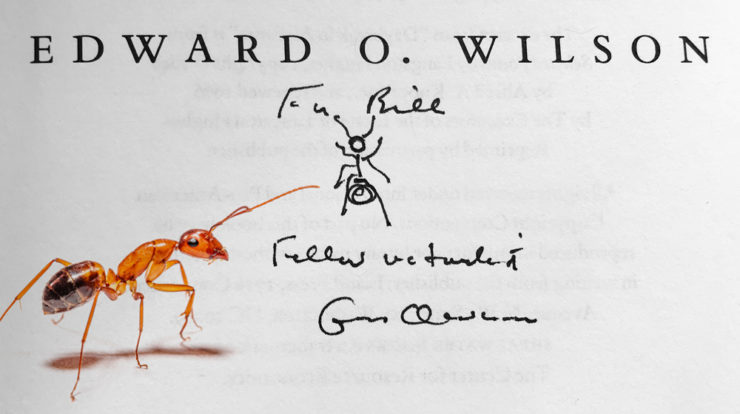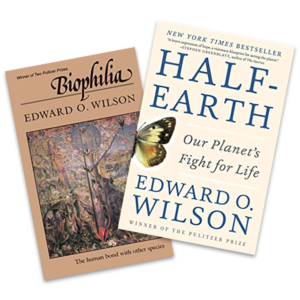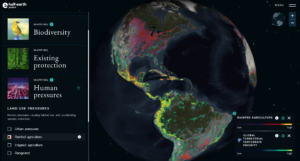

Features
Ed Wilson, Our Naturalist and Half-Earth Hero
Terrapin Bright Green
Share
A man to whom Terrapin owes much of our passion and focus passed away last month. Edward O. Wilson made multiple contributions to science and society. His focus on ants and their behaviors led to a sometimes controversial exploration of innate vs learned behavior in other species—sociobiology, a field in which he was a pioneer. Wilson felt that with there being more than 13,000 species, making up two-thirds of the biomass of insects on the earth, ants were a crucial part of keeping ecosystems functioning. He said that while most kids go through a bug phase, he never grew out of his, as is evident in his signature which he frequently accompanied with a sketch of an ant (see blog header image).
His work on the limits to species diversity on islands – island biogeography – helped lead to the understanding that we need large habitat areas with safe connections between them to preserve biodiversity. This was the subject of some of his last work and the launch of the Half-Earth Project to keep half the area of the world for species other than humans. Wilson pointed out that if humans were to disappear, most ecosystems can restore themselves within a few thousand years; whereas, if some species like the ants were to disappear, those same ecosystems may collapse and with them human society. Thus, saving other species isn’t just nice, it’s necessary. To keep those species around they need space, and our tolerance. There are nearly 8 billion people in the world, but there are less than half a million elephants and less than 4,000 tigers left in the wild.
This goal for half of the land devoted to ecosystems is ambitious. Our existing national parks and wildlife refuges are simply not enough. They are small islands that need to be connected in order to preserve species. These large, bold moves will take time as well as attention to human needs. The Biophilic Cities Network, for one, is encouraging cities to work to limit damaging impacts beyond the borders of cities, they also believe that “through the conservation of remnant habitat and the nurturing of unique human-influenced habitats found only in cities, new spaces and connections through and across the urban landscape can be forged”. Through this mindset, as urban and suburban dwellers, we can engage by restoring and conserving habitat in our urban parks and land bridges, coastlines and waterways, and our community gardens; by rewilding our lawns and backyards and creating new habitat on our terraces and rooftops to string together contiguous green space, to protect both resident species and migratory ones. We will all benefit from having a Half-Earth mindset.

For Terrapin, part of our mindset is thinking about not just preserving species diversity, but also restoring ecosystem services like pollination, cleaning stormwater, sequestering carbon, and supporting human health and wellbeing.
On that topic, for Terrapin, a major source of inspiration has been the small but profound book about Wilson’s emotional connection to nature, Biophilia. Wilson was the one who gave us our working definition of biophilia as an innate connection to nature—this was perhaps his biggest contribution to architecture and planning.
Over the last several years there has been increasing interest in the topic of biophilia and, in particular, on how biophilic design can improve our health and wellbeing. Many papers explore the mechanisms of stress reduction or cognitive improvement associated with experiences of nature. These are important, significant and valuable. While we have been focusing so much on the physiological or neurological responses to nature, I fear we may have forgotten what Wilson was trying to get at all along—for us to remember the joy and love for other living things. Biophilia is literally the love of nature.
Carry on Ed Wilson’s legacy. Take action!
- Read up on biophilic design. Refer to our list of Recommended Biophilia Readings.
- Download and read The Half-Earth City by Tim Beatley and JD Brown, published in William & Mary Environmental Law and Policy Review.
- Explore the Half-Earth Maps (shown above) of biodiversity, existing protections, and human pressures. What are the biggest concerns and opportunities in your region?
- Become a Half-Earth Project Education Ambassador. Help inspire young minds and community groups!
Topics
- Environmental Values
- Speaking
- LEED
- Terrapin Team
- Phoebe
- Community Development
- Greenbuild
- Technology
- Biophilic Design Interactive
- Catie Ryan
- Spanish
- Hebrew
- French
- Portuguese
- Publications
- Occupant Comfort
- Materials Science
- Conference
- Psychoacoustics
- Education
- Workshop
- Mass Timber
- Transit
- Carbon Strategy
- connection with natural materials
- interior design
- inspirational hero
- biophilia
- economics of biophilia
- Sustainability
- wood
- case studies
- Systems Integration
- Biophilic Design
- Commercial
- Net Zero
- Resorts & Hospitality
- Energy Utilization
- Water Management
- Corporations and Institutions
- Institutional
- Ecosystem Science
- Green Guidelines
- Profitability
- Climate Resiliency
- Health & Wellbeing
- Indoor Environmental Quality
- Building Performance
- Bioinspired Innovation
- Biodiversity
- Residential
- Master Planning
- Architects and Designers
- Developers and Building Owners
- Governments and NGOs
- Urban Design
- Product Development
- Original Research
- Manufacturing
- Industrial Ecology
- Resource Management
- Sustainability Plans
- Health Care
- Carbon Neutrality



